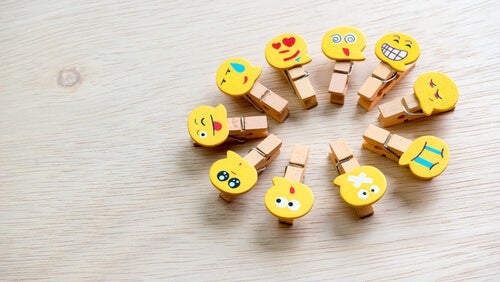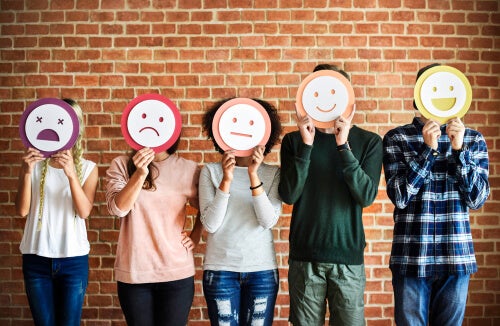Do You Know What Your Basic and Secondary Emotions Are?

Understanding your basic and secondary emotions will allow you to develop on a personal and relational level. Those who have more social skills usually know themselves and the emotions they’re feeling at any given moment. They’re able to learn, interpret, and use these skills to relate to others. They can recognize other people’s emotions and the situations that originate different emotions. So, how can we define our emotions?
Paul Ekman’s theory defines six basic emotions: anger, sadness, joy, fear, surprise, and disgust. These are identified as basic or primary emotions because they’re cross-cultural and innate. In other words, we already have them from childhood. The facial expressions related to them don’t vary according to society and they’re recognized anywhere in the world.
Secondary emotions, on the other hand, are influenced by individual societies. Depending on their history and culture, they’ll be expressed in different ways. In addition to that, you need interpersonal contact to develop them. Some examples are shame, contempt, guilt, and pride, among many others.
Currently, there are many studies devoted to the recognition and identification of emotions. Some theories say that there are only four basic emotions, and others say there are many more and add some of the secondary ones. Whatever the case, the important thing is to know how to identify, recognize, and learn to act in accordance with all of them.
“Feelings or emotions are the universal language and are to be honored. They’re the authentic expression of who you are at your deepest place.”
-Judith Wright-

Basic and secondary emotions
All emotions are adaptive. Even though some seem positive (such as joy) and others negative (such as sadness, anger, or disgust), in reality, they all help us to adapt to our surroundings. It’s for this reason that it may be better to define them as either “pleasant” or “unpleasant”, in order to avoid categorizing them as either positive or negative.
We also define secondary emotions, because sometimes they’re the combination of several basic emotions. For example, jealousy could contain fear and anger or shame could include the fear of rejection and sadness for having failed. These emotions need to interact and help you grow. This way, you’ll learn more about what you’re feeling in different situations or conflicts.
A curious fact that we could highlight is that the only emotion we can define as neutral is surprise. This emotion is the one that lasts the least, as it quickly turns into another emotion. For example, if it’s a pleasant surprise, it’ll turn into joy. However, if the surprise isn’t to our liking, then it could turn into sadness or anger.
Even so, as we mentioned above, basic and secondary emotions are always adaptive. For example, disgust helps you not eat food that may be spoiled. Fear protects you from stimuli that can be harmful to your survival. Finally, sadness protects you by giving you space to be calm and think clearly.
Emotional education: the foundation for correct development
Good personal development requires the development of academic and emotional intelligence. The correct identification and recognition of emotions means that you’ll be able to make good use of them and know how to act with others and yourself.
Knowing all the emotions that exist and how each one makes you feel is somewhat empowering because it provides you with self-knowledge and the capacity to connect with others.

In addition, emotional education allows you to boost your self-esteem, because, as you know how you’re really feeling, this will give you more confidence about how to approach the situation. In addition to this, your social functioning will also improve, as you’ll build better skills and relationships. If you can identify how other people are feeling, then it’ll be easier for you to relate to them as well.
As you can see, understanding your own emotions will help you to grow in a balanced way. As you’ll be able to recognize them, you’ll be able to express them properly. A perfect example is fear. If you don’t handle it correctly, it could turn into a phobia or panic attack.
You are who you are and your emotions, both basic and secondary, are an essential part of your make up. By understanding them well and how to express them correctly, you’ll grow as a person.
Understanding your basic and secondary emotions will allow you to develop on a personal and relational level. Those who have more social skills usually know themselves and the emotions they’re feeling at any given moment. They’re able to learn, interpret, and use these skills to relate to others. They can recognize other people’s emotions and the situations that originate different emotions. So, how can we define our emotions?
Paul Ekman’s theory defines six basic emotions: anger, sadness, joy, fear, surprise, and disgust. These are identified as basic or primary emotions because they’re cross-cultural and innate. In other words, we already have them from childhood. The facial expressions related to them don’t vary according to society and they’re recognized anywhere in the world.
Secondary emotions, on the other hand, are influenced by individual societies. Depending on their history and culture, they’ll be expressed in different ways. In addition to that, you need interpersonal contact to develop them. Some examples are shame, contempt, guilt, and pride, among many others.
Currently, there are many studies devoted to the recognition and identification of emotions. Some theories say that there are only four basic emotions, and others say there are many more and add some of the secondary ones. Whatever the case, the important thing is to know how to identify, recognize, and learn to act in accordance with all of them.
“Feelings or emotions are the universal language and are to be honored. They’re the authentic expression of who you are at your deepest place.”
-Judith Wright-

Basic and secondary emotions
All emotions are adaptive. Even though some seem positive (such as joy) and others negative (such as sadness, anger, or disgust), in reality, they all help us to adapt to our surroundings. It’s for this reason that it may be better to define them as either “pleasant” or “unpleasant”, in order to avoid categorizing them as either positive or negative.
We also define secondary emotions, because sometimes they’re the combination of several basic emotions. For example, jealousy could contain fear and anger or shame could include the fear of rejection and sadness for having failed. These emotions need to interact and help you grow. This way, you’ll learn more about what you’re feeling in different situations or conflicts.
A curious fact that we could highlight is that the only emotion we can define as neutral is surprise. This emotion is the one that lasts the least, as it quickly turns into another emotion. For example, if it’s a pleasant surprise, it’ll turn into joy. However, if the surprise isn’t to our liking, then it could turn into sadness or anger.
Even so, as we mentioned above, basic and secondary emotions are always adaptive. For example, disgust helps you not eat food that may be spoiled. Fear protects you from stimuli that can be harmful to your survival. Finally, sadness protects you by giving you space to be calm and think clearly.
Emotional education: the foundation for correct development
Good personal development requires the development of academic and emotional intelligence. The correct identification and recognition of emotions means that you’ll be able to make good use of them and know how to act with others and yourself.
Knowing all the emotions that exist and how each one makes you feel is somewhat empowering because it provides you with self-knowledge and the capacity to connect with others.

In addition, emotional education allows you to boost your self-esteem, because, as you know how you’re really feeling, this will give you more confidence about how to approach the situation. In addition to this, your social functioning will also improve, as you’ll build better skills and relationships. If you can identify how other people are feeling, then it’ll be easier for you to relate to them as well.
As you can see, understanding your own emotions will help you to grow in a balanced way. As you’ll be able to recognize them, you’ll be able to express them properly. A perfect example is fear. If you don’t handle it correctly, it could turn into a phobia or panic attack.
You are who you are and your emotions, both basic and secondary, are an essential part of your make up. By understanding them well and how to express them correctly, you’ll grow as a person.
This text is provided for informational purposes only and does not replace consultation with a professional. If in doubt, consult your specialist.







